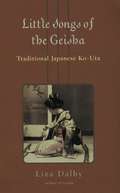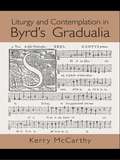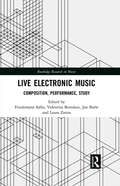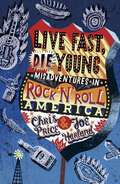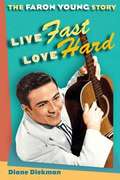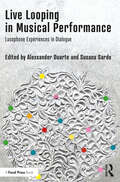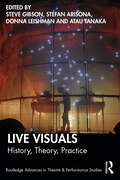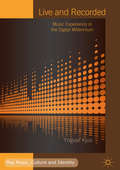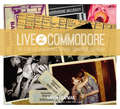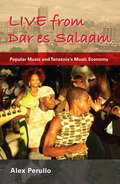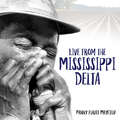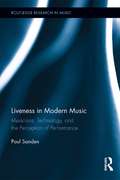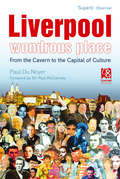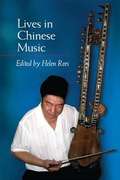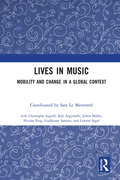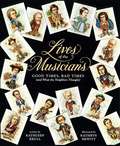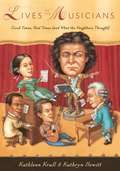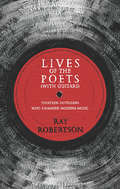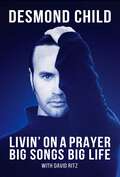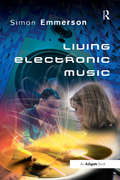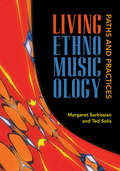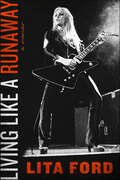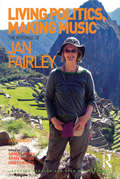- Table View
- List View
Little Songs of the Geisha
by Liza DalbyA fascinating look into the world of the Geisha through the 400-year-old art of Ko-Uta, the traditional song form sung to three-stringed shamisen music. A vivid evocation of the romanticism of feudal Japan.
Liturgy and Contemplation in Byrd's Gradualia
by Kerry McCarthyWilliam Byrd’s Gradualia is one of the most unusual and elaborate musical works of the English Renaissance. <P><P> This large collection of liturgical music, 109 pieces in all, was written for clandestine use by English Catholics at a time when they were forbidden to practice their religion in public. When Byrd began to compose the Gradualia, he turned from the penitential and polemical extravagances of his earlier Latin motets to the narrow, carefully ordered world of the Counter-Reformation liturgy. It was in this new context, cut off from his familiar practice of choosing colorful texts and setting them at length, that he first wrote about the "hidden and mysterious power" of sacred words to evoke a creative response. <P><P> Liturgy and Contemplation in Byrd’s Gradualia responds to Byrd’s own testimony by exploring how he read the texts of the Mass and the events of the church calendar. Kerry McCarthy examines early modern English Catholic attitudes toward liturgical practice, meditation, and what the composer himself called "thinking over divine things." She draws on a wide range of contemporary sources — devotional treatises, commentaries on the Mass, poetry, memoirs, letters, and Byrd’s dedicatory prefaces — and revisits the Gradualia in light of this evidence. The book offers a case study of how one artist reimagined the creative process in the final decades of his life.
Live Electronic Music: Composition, Performance, Study (Routledge Research in Music)
by Friedemann Sallis Valentina Bertolani Jan Burle Laura ZattraDuring the twentieth century, electronic technology enabled the explosive development of new tools for the production, performance, dissemination and conservation of music. The era of the mechanical reproduction of music has, rather ironically, opened up new perspectives, which have contributed to the revitalisation of the performer’s role and the concept of music as performance. This book examines questions related to music that cannot be set in conventional notation, reporting and reflecting on current research and creative practice primarily in live electronic music. It studies compositions for which the musical text is problematic, that is, non-existent, incomplete, insufficiently precise or transmitted in a nontraditional format. Thus, at the core of this project is an absence. The objects of study lack a reliably precise graphical representation of the work as the composer or the composer/performer conceived or imagined it. How do we compose, perform and study music that cannot be set in conventional notation? The authors of this book examine this problem from the complementary perspectives of the composer, the performer, the musical assistant, the audio engineer, the computer scientist and the musicologist.
Live Fast, Die Young: Misadventures in Rock And Roll America
by Chris Price Joe HarlandDisappointed to learn that Hotel California isn’t actually in the phone book, radio producers Chris and Joe resolve to seek out the true spirit of rock and roll America. Roof down and stereo up, they drive coast to coast on a mission to ‘live the music’. It’s a tale of friendship tested to the limit, great melodies, and noble myths.
Live Fast, Die Young: Misadventures in Rock And Roll America
by Chris Price Joe HarlandDisappointed to learn that Hotel California isn’t actually in the phone book, radio producers Chris and Joe resolve to seek out the true spirit of rock and roll America. Roof down and stereo up, they drive coast to coast on a mission to ‘live the music’. It’s a tale of friendship tested to the limit, great melodies, and noble myths.
Live Fast, Love Hard: The Faron Young Story
by Diane DiekmanAs one of the best-known honky tonkers to appear in the wake of Hank Williams's death, Faron Young was a popular presence on Nashville's music scene for more than four decades. The Singing Sheriff produced a string of Top Ten hits, placed over eighty songs on the country music charts, and founded the long-running country music periodical Music City News in 1963. Flamboyant, impulsive, and generous, he helped and encouraged a new generation of talented songwriter-performers that included Willie Nelson and Bill Anderson. In 2000, four years after his untimely death, Faron was inducted into the Country Music Hall of Fame. Presenting the first detailed portrayal of this lively and unpredictable country music star, Diane Diekman masterfully draws on extensive interviews with Young's family, band members, and colleagues. Impeccably researched, Diekman's narrative also weaves anecdotes from Louisiana Hayride and other old radio shows with ones from Young's business associates, including Ralph Emery. Her unique insider's look into Young's career adds to an understanding of the burgeoning country music entertainment industry during the key years from 1950 to 1980, when the music expanded beyond its original rural roots and blossomed into a national (ultimately, international) enterprise. Echoing Young's characteristic ability to entertain and surprise fans, Diekman combines an account of his public career with a revealing, intimate portrait of his personal life.
Live Looping in Musical Performance: Lusophone Experiences in Dialogue
by Alexsander Duarte Susana SardoLive Looping in Musical Performance offers a diverse range of interdisciplinary perspectives on the application of live looping technology by lusophone performers and composers. This book explores various aspects, including the aesthetic component, instrumentation, and setup, highlighting the versatility of this technology in music-making. Written by musicians and researchers from Portuguese-speaking countries, this book comprises eleven chapters that delve into various musical contexts, genres, and practices. The novelty of including collaborative texts written alongside non-professional researchers offers the possibility of drawing from real experience to consider how live looping has been changing and "cyborguising" the concept of music, the ritual of the performance, the identity of the musicians, and the public's expectations. Live Looping in Musical Performance provides cutting-edge reading for composers and performers, as well as ethnomusicologists, students, and researchers working in the areas of music production, technology, and performance. This book addresses a broader audience, both academic and non-academic, who are interested in new processes of musical creativity in a post-human world.
Live Visuals: History, Theory, Practice (Routledge Advances in Theatre & Performance Studies)
by Steve Gibson Stefan Arisona Donna Leishman Atau TanakaThis volume surveys the key histories, theories and practice of artists, musicians, filmmakers, designers, architects and technologists that have worked and continue to work with visual material in real time. Covering a wide historical period from Pythagoras’s mathematics of music and colour in ancient Greece, to Castel’s ocular harpsichord in the 18th century, to the visual music of the mid-20th century, to the liquid light shows of the 1960s and finally to the virtual reality and projection mapping of the present moment, Live Visuals is both an overarching history of real-time visuals and audio-visual art and a crucial source for understanding the various theories about audio-visual synchronization. With the inclusion of an overview of various forms of contemporary practice in Live Visuals culture – from VJing to immersive environments, architecture to design – Live Visuals also presents the key ideas of practitioners who work with the visual in a live context. This book will appeal to a wide range of scholars, students, artists, designers and enthusiasts. It will particularly interest VJs, DJs, electronic musicians, filmmakers, interaction designers and technologists.
Live and Recorded
by Yngvar KjusThis book uncovers how music experience–live and recorded–is changing along with the use of digital technology in the 2000s. Focussing on the Nordic region, this volume utilizes the theory of mentalization: the capacity to perceive and interpret what others are thinking and feeling, and applies it to the analysis of mediated forms of agency in popular music. The rise of new media in music production has enabled sound recording and processing to occur more rapidly and in more places, including the live concert stage. Digital technology has also introduced new distribution and consumption technologies that allow record listening to be more closely linked to the live music experience. The use of digital technology has therefore facilitated an expanding range of activities and experiences with music. Here, Yngvar Kjus addresses a topic that has a truly global reach that is of interest to scholars of musicology, media studies and technology studies.
Live at the Commodore
by Aaron ChapmanVancouver's Commodore Ballroom is, like New York's CBGB's and Los Angeles's Whiskey a Go-Go, one of the most venerated rock clubs in the world; originally built in 1930, it's hosted a who's-who of music greats before they made it big: The Police, The Clash, Blondie, Talking Heads, Nirvana, New York Dolls, U2, and, more recently, Lady Gaga and the White Stripes. Filled with never-before-published photographs, posters, and paraphernalia, Live at the Commodore is a visceral, energetic portrait of one of the world's great rock venues.Aaron Chapman is a musician and journalist, and the author of Liquor, Lust, and the Law.
Live from Dar es Salaam: Popular Music and Tanzania's Music Economy (African Expressive Cultures)
by Alex PerulloWhen socialism collapsed in Tanzania, the government-controlled music industry gave way to a vibrant independent music scene. Alex Perullo explores the world of the bands, music distributors, managers, and clubs that attest to the lively and creative music industry in Dar es Salaam. Perullo examines the formation of the city's music economy, considering the means of musical production, distribution, protection, broadcasting, and performance. He exposes both legal and illegal strategies for creating business opportunities employed by entrepreneurs who battle government restrictions and give flight to their musical aspirations. This is a singular look at the complex music landscape in one of Africa's most dynamic cities.
Live from the Mississippi Delta
by Panny Flautt MayfieldLive from the Mississippi Delta showcases a rare collection of photographs and stories about musicians from Robert Plant, B. B. King, and ZZ Top to local guitarists playing gigs on the weekend. Panny Flautt Mayfield, a lifelong Delta resident from Tutwiler and an award-winning journalist, documents multiple decades of blues and gospel music in her native land. Her first book collects over two hundred black-and-white and color photographs from a long career of photographing live music. Featuring text by Robert Plant in honor of Mayfield, the book opens with him addressing senior citizens gathered in Tutwiler to honor their town as the birthplace of blues. From there, the book proceeds throughout the Delta from juke joints and festivals to blues markers and museums. Mayfield presents images and tales of local icons such as Early Wright, Wade Walton, and the Jelly Roll Kings, as well as international celebrities. She shares intimate photos, including Garth Brooks and Bobby Rush charming elementary school kids in West Tallahatchie, along with insider stories and photos of B. B. King's Homecoming, the Governor's Awards, the Delta Blues Museum, the Sunflower and King Biscuit festivals, and a fascinating side trip to Norway's Notodden Blues Festival, which has a rich sister-city relationship with Clarksdale and the Sunflower Festival. Years ago volunteer tour guide Shirley Fair announced to visitors that there is a church or a juke joint on every corner in Clarksdale. Those demographics are still mostly accurate. Igniting a high-octane finale are photographs taken at iconic juke joints such as Smitty's Red Top, the Bobo Grocery, the Rivermount Lounge, Po' Monkey's, Hopson, Shelby's Dew Drop Inn, the Rose, Ground Zero, Sarah's Kitchen, Margaret's Blue Diamond, and Red's.
Liveness in Modern Music: Musicians, Technology, and the Perception of Performance (Routledge Research in Music)
by Paul SandenThis study investigates the idea and practice of liveness in modern music. Understanding what makes music live in an ever-changing musical and technological terrain is one of the more complex and timely challenges facing scholars of current music, where liveness is typically understood to represent performance and to stand in opposition to recording, amplification, and other methods of electronically mediating music. The book argues that liveness itself emerges from dynamic tensions inherent in mediated musical contexts—tensions between music as an acoustic human utterance, and musical sound as something produced or altered by machines. Sanden analyzes liveness in mediatized music (music for which electronic mediation plays an intrinsically defining role), exploring the role this concept plays in defining musical meaning. In discussions of music from both popular and classical traditions, Sanden demonstrates how liveness is performed by acts of human expression in productive tension with the electronic machines involved in making this music, whether on stage or on recording. Liveness is not a fixed ontological state that exists in the absence of electronic mediation, but rather a dynamically performed assertion of human presence within a technological network of communication. This book provides new insights into how the ideas of performance and liveness continue to permeate the perception and reception of even highly mediatized music within a society so deeply invested, on every level, with the use of electronic technologies.
Liverpool - Wondrous Place: From the Cavern to the Capital of Culture
by Paul Du NoyerNo other city in the world is as well known or loved for its vibrant and definitive musical history as Liverpool. In 2002, Guinness World Records: British Hit Singles voted Liverpool 'World Capital of Pop', recognising that Liverpool's homegrown talent has produced more number one hit singles per capita than anywhere else in the world. In 2008, Liverpool will celebrate its crown as European Capital of Culture. Paul Du Noyer's acclaimed book takes us on a tour of the rich musical history of his hometown, from the world-famous Cavern Club in Mathew Street, host to the Beatles' debut performance in 1961, to the city's musical future with contemporary bands like The Zutons. Featuring interviews with key figures of the music scene, this book reveals the creative impulse behind Britain's most musical city. Find out why Liverpool is not just a place where music happens. The city is the reason music happens.
Lives in Chinese Music
by Helen ReesUntil recently, most scholarly work on Chinese music in both Chinese and Western languages has focused on genres, musical structure, and general history and concepts, rather than on the musicians themselves. This volume breaks new ground by focusing on individual musicians active in different amateur and professional music scenes in mainland China, Hong Kong, and Chinese communities in Europe. Using biography to deepen understanding of Chinese music, contributors present contextualized portraits of rural folk singers, urban opera singers, literati, and musicians on both geographic and cultural frontiers. Contributors are Nimrod Baranovitch, Rachel Harris, Frank Kouwenhoven, Tong Soon Lee, Peter Micic, Helen Rees, Antoinet Schimmelpenninck, Shao Binsun, Jonathan P. J. Stock, and Bell Yung.
Lives in Music: Mobility and Change in a Global Context (Routledge Studies in Ethnomusicology)
by Sara Le Menestrel Christophe Apprill Kali Argyriadis Julien Mallet Nicolas Puig Guillaume Samson Gabriel SegréLives in Music analyses interwoven patterns of mobility, change, and power in music and dance practices. It challenges some commonly accepted conceptual tools that are ubiquitous in anthropology today, including cultural hybridity, transnational networks, and globalization. Based on seven “itineraries” that are the result of extensive ethnographic long-term field research efforts, the processes of geographic and social mobility, transformation, and power relative to music and dance practices are explored in different parts of the world. Seven writers provide “itineraries” constructed through ethnographic techniques and life histories and supported by a deep knowledge of local customs.
Lives of the Musicians: Good Times, Bad Times (And What the Neighbors Thought)
by Kathleen KrullThe lives of twenty composers and musicians, ranging from Vivaldi, Mozart, and Bach to Gershwin, Gilbert 6a Sullivan, and Woody Guthrie, are profiled in this eclectic, humorous, and informative collection.
Lives of the Musicians: Good Times, Bad Times (and What the Neighbors Thought)
by Kathleen Krull Kathryn HewittIt's no secret that Beethoven went deaf, that Mozart had constant money problems, and that Gilbert and Sullivan wrote musicals. But what were these people—and other famous musicians—really like? What did they eat? What did they wear? How did they spend their time? And—possibly most interesting of all—what did their neighbors think? Discover the fascinating and often humorous stories of twenty famous musicians—people of all shapes, sizes, temperaments, and lifestyles, from various countries and historical periods. Beginning with Vivaldi and ending with Woodie Guthrie, Lives of the Musicians brings musical history to life!
Lives of the Poets (with Guitars): Thirteen Outsiders Who Changed Rock & Roll
by Ray Robertson"The days of poets moping around castle steps wearing black capes is over. The poets of today are amplified."- LEONARD COHENPicking up where Samuel Johnson left off more than two centuries ago, Ray Robertson's Lives of the Poets (with Guitars) offers up an amplified gathering of thirteen portraits of rock & roll, blues, folk, and alt-country's most inimitable artists. Irreverent and riotous, Robertson explores the "greater or lesser heat" with which each musician shaped their genre, while offering absorbing insight into their often tumultuous lives.Includes essays on Gene Clark, Ronnie Lane, The Ramones, Sister Rosetta Tharpe, Townes Van Zandt, Little Richard, Alan Wilson, Willie P. Bennett, Gram Parsons, Hound Dog Taylor, Paul Siebel, Willis Alan Ramsey, and John Hartford.
Livin' On A Prayer: Big Songs Big Life
by Desmond ChildDesmond Child is the ultimate hitmaker, contributing to some of the biggest smash global hits that helped ignite the success of music icons KISS, Bon Jovi, Aerosmith, Alice Cooper, Ricky Martin, Katy Perry, and countless others. In Livin' On A Prayer, he reveals how he climbed his way to the top and beyond amid extraordinary circumstances and shares his very personal and unbelievable journey that shaped him into an artist of international renown. For over half a century, Desmond Child has collaborated with the world's most celebrated artists creating timeless hits, such as Bon Jovi's Livin' On A Prayer and You Give Love A Bad Name as well as Ricky Martin's Livin' La Vida Loca and The Cup Of Life amongst his vast catalog. But in Livin' On A Prayer, Desmond himself takes center stage to share his transformational story from misfit outsider to cultural pacesetter. In collaboration with legendary music biographer David Ritz, Child recounts his unconventional upbringing as his colorful family fled Cuba in the 1960s and fell into poverty. He details his shocking discovery at age 18 that the man he called dad was not his biological father after all, and he courageously bares his soul about navigating the trials of being a Latino gay man in the macho world of rock and roll. His is a story of willing himself to succeed and overcome impossible odds to establish himself as one of the most influential composers and lyricists of all time.
Living Electronic Music
by Simon EmmersonDrawing on recent ideas that explore new environments and the changing situations of composition and performance, Simon Emmerson provides a significant contribution to the study of contemporary music, bridging history, aesthetics and the ideas behind evolving performance practices. Whether created in a studio or performed on stage, how does electronic music reflect what is live and living? What is it to perform 'live' in the age of the laptop? Many performer-composers draw upon a 'library' of materials, some created beforehand in a studio, some coded 'on the fly', others 'plundered' from the widest possible range of sources. But others refuse to abandon traditionally 'created and structured' electroacoustic work. Lying behind this maelstrom of activity is the perennial relationship to 'theory', that is, ideas, principles and practices that somehow lie behind composers' and performers' actions. Some composers claim they just 'respond' to sound and compose 'with their ears', while others use models and analogies of previously 'non-musical' processes. It is evident that in such new musical practices the human body has a new relationship to the sound. There is a historical dimension to this, for since the earliest electroacoustic experiments in 1948 the body has been celebrated or sublimated in a strange 'dance' of forces in which it has never quite gone away but rarely been overtly present. The relationship of the body performing to the spaces around has also undergone a revolution as the source of sound production has shifted to the loudspeaker. Emmerson considers these issues in the framework of our increasingly 'acousmatic' world in which we cannot see the source of the sounds we hear.
Living Ethnomusicology: Paths and Practices
by Ted Solis Margaret SarkissianEthnomusicologists have journeyed from Bali to Morocco to the depths of Amazonia to chronicle humanity's relationship with music. Margaret Sarkissian and Ted Solís guide us into the field's last great undiscovered country: ethnomusicology itself. Drawing on fieldwork based on person-to-person interaction, the editors provide a first-ever ethnography of the discipline. The unique collaborations produce an ambitious exploration of ethnomusicology's formation, evolution, practice, and unique identity. In particular, the subjects discuss their early lives and influences and trace their varied career trajectories. They also draw on their own experiences to offer reflections on all aspects of the field. Pursuing practitioners not only from diverse backgrounds and specialties but from different eras, Sarkissian and Solís illuminate the many trails ethnomusicologists have blazed in the pursuit of knowledge. A bountiful resource on history and practice, Living Ethnomusicology is an enlightening intellectual exploration of an exotic academic culture.
Living Genres in Late Modernity: American Music of the Long 1970s
by Charles KronengoldLiving Genres in Late Modernity rehears the American 1970s through the workings of its musical genres. Exploring stylistic developments from the late 1960s through the early 1980s, including soul, funk, disco, pop, the nocturne, and the concerto, Charles Kronengold treats genres as unstable constellations of works, people, practices, institutions, technologies, money, conventions, forms, ideas, and multisensory experiences. What these genres share is a significant cultural moment: they arrive just after "the sixties" and are haunted by a sense of belatedness, loss, or doubt, even as they embrace narratives of progress or abundance. These genres give us reasons—and means—to examine our culture’s self-understandings. Through close readings and large-scale mappings of cultural and stylistic patterns, the book’s five linked studies reveal how genres help construct personal and cultural identities that are both partial and overlapping, that exist in tension with one another, and that we experience in ebbs and flows.
Living Like a Runaway: A Memoir
by Lita FordFearless, revealing, and compulsively readable, Lita Ford’s Living Like a Runaway is the long-awaited memoir from one of rock’s greatest pioneers—and fiercest survivors. “Heavy metal’s leading female rocker" (Rolling Stone) bares all, opening up about the Runaways, the glory days of the punk and hard-rock scenes, and the highs and lows of her trailblazing career.Wielding her signature black guitar, Lita Ford shredded stereotypes of female musicians throughout the 1970s and ‘80s. Then followed more than a decade of silence and darkness—until rock and roll repaid the debt it owed this pioneer, helped Lita reclaim her soul, and restored the Queen of Metal to her throne.In 1975, Lita Ford left home at age sixteen to join the world’s first major all-female rock group, the Runaways—a “pioneering band” (New York Times) that became the subject of a Hollywood movie starring Kristen Stewart ad Dakota Fanning. Lita went on to become “heavy rock’s first female guitar hero” (Washington Post), a platinum-selling solo star who shared the bill with the Ramones, Van Halen, Motley Crue, Bon Jovi, Def Leppard, Poison, and others and who gave Ozzy Osbourne his first Top 10 hit. She was a bare-ass, leather-clad babe whose hair was bigger and whose guitar licks were hotter than any of the guys’.Hailed by Elle as “one of the greatest female electric guitar players to ever pick up the instrument,” Lita spurred the meteoric rise of Joan Jett, Cherie Currie, and the rest of the Runaways. Her phenomenal talent on the fret board also carried her to tremendous individual success after the group’s 1979 disbandment, when she established herself as a “legendary metal icon” (Guitar World) and a fixture of the 1980s music scene who held her own after hours with Nikki Sixx, Jon Bon Jovi, Eddie Van Halen, Tommy Lee, Motorhead’s Lemmy, Black Sabbath’s Tony Iommi (to whom she was engaged), and others.Featuring a foreword by Dee Snider, Living Like a Runaway also provides never-before-told details of Lita’s dramatic personal story. For Lita, life as a woman in the male-dominated rock scene was never easy, a constant battle with the music establishment. But then, at a low point in her career, came a tumultuous marriage that left her feeling trapped, isolated from the rock-and-roll scene for more than a decade, and—most tragically—alienated from her two sons. And yet, after a dramatic and emotional personal odyssey, Lita picked up her guitar and stormed back to the stage. As Guitar Player hailed in 2014 when they inducted her into their hall of fame of guitar greats: “She is as badass as ever.”
Living Politics, Making Music: The Writings of Jan Fairley (Ashgate Popular and Folk Music Series)
by Ian Christie Jan Fairley edited by FrithThe late Jan Fairley (1949-2012) was a key figure in making world music a significant topic for popular music studies and an influential contributor to such world music magazines as fRoots and Songlines. This book celebrates her contribution to popular music scholarship by gathering her most important work together in a single place. The result is a richly informed and entertaining volume that will be of interest to all scholars in the field while also serving as an excellent introduction for students interested in popular music as a global phenomenon. Fairley’s work was focused on the problems and possibilities of cross-cultural musical influences, fantasies and flows and on the importance of performing circuits and networks. Her interest in the details of music-making and in the lives of music-makers means that this collection is also an original and illuminating study of music and politics. In drawing on Jan Fairley’s journalism, this volume also offers students a guide to various genres of world music, from Cuban son to flamenco, as well as an insight into the lives of such world music stars as Mercedes Sosa and Silvio RodrÃguez. This is inspiring as well as essential reading.
